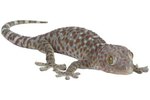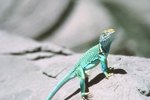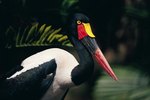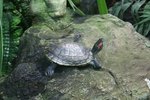
The dinosaurs who ruled all that fell under their shadows disappeared from the living eons ago, but their kind live on, perhaps in your yard: Those little lizards and chirping chickadees have dinosaurs in their lineage. Millions of years ago dinosaurs flew, swam and walked the earth, and came in every size imaginable. All but wiped out, they left some DNA that evolved into modern-day reptiles and even birds.
The Origin of Reptiles
All reptiles, in fact all vertebrates, evolved from amphibians who developed the ability to leave aquatic life for land. Reptiles differentiated from amphibians when they evolved two key traits: waterproof skin and the ability to lay shelled eggs that contain their own nutrient and moisture supplies. These adaptations are what allowed them to propagate the planet and dominate Earth for 100 million years during the Mesozoic era, which is considered "the age of the reptiles." Dinosaurs were the first reptiles.
Dinosaurs -- Ancestors to Modern Reptiles
The Reptilia class contains four orders, which differ greatly from each other. They are the Testudines, tortoises and turtles; Squamata, lizards and snakes; Crocodylia, crocodiles, alligators and caymans; and Rhynchocephalia, the lizardlike tuataras. Genetic relationships have been proven between dinosaurs and birds, as well as orders of Squamata, Crocodylia and Rhynochocephalia, but links between Testudines and dinosaurs have not been found, even though animals belonging to this order have existed just as long as the dinosaurs.
From Giant Monster to Humble Household Pet
Animals in Order Squamata, like geckos, chameleons and skinks, come from ancestors who evolved during the Triassic Period of the Mesozoic Era. Reptiles in this group adapted to changing conditions after the cataclysmic event that decimated the dinosaurs, especially to new climates that emerged from a previously uniformly warm, wet world. The Rhynchocephalia are closely related to the Squamata. Only two species are left in this group -- Sphenodon punctatus and S. guntheri. Crocodylomorpha, the group containing crocodiles and related four-legged reptiles, goes back about 200 million years. Crocodyliforms first appeared during the Triassic period. Ancient crocodiles and birds are descended from the same ancient reptile group, the archosaurs. Crocodylians are among the rare animal groups that have survived uninterrupted for hundreds of millions of years. However, ancient crocodylians differ greatly from modern-day crocs. Some were terrestrial, some aquatic, and they ranged in size from a few feet to more than 50 feet long.
The Dino-Bird Connection
Dinosaurs can be divided into two groups -- avian and nonavian, or flying and nonflying. Extensive research and comparison of fossils to modern-day birds provides evidence that avian dinosaurs evolved into the birds of today, and birds can actually be classified as a kind of reptile. Specifically, birds are descended from theropods, or two-legged dinosaurs. Flightless birds like kiwis and ostriches provide strong evidence of this theory. The strongest link scientists have found is between birds and maniraptoran dinosaurs -- theropods with large, grasping hands tipped with menacing claws. As far back as the 1500s, anatomists noted the similarities between some dinosaur fossils and those of birds, most notably Archaeopteryx, a clear link between dinosaur and bird morphology. For example, birds have scales on their feet, and feathers are a modified form of scale. Birds also lay hard-shelled eggs similar to dinosaurs and other reptiles.
References
- University of California, Berkeley: DinoBuzz - Are Birds Really Dinosaurs?
- Encylopedia of Life: What Is a Reptile?
- University of California, Berkeley: DinoBuzz - Hot-Blooded or Cold-Blooded??
- In the Shadow of the Dinosaurs: Early Mesozoic Tetrapods: Nicholas C. Fraser; Hans-Dieter Sues, ed., et al.
- Encyclopedia of Dinosaurs: Philip J. Currie; Kevin Padian, ed., et al.
- UCL - London's Global University: Vertebrate Diversity - Rhynchocephalians
Resources
Photo Credits
-
Photos.com/Photos.com/Getty Images
Writer Bio
Madeline Masters works as a dog walker and professional writer. In the past she has worked as a fitness columnist, fundraising copywriter and news reporter. Masters won two Pennsylvania Newspaper Association Awards in 2009. She graduated from Elizabethtown College with a Bachelor of Arts in English.




